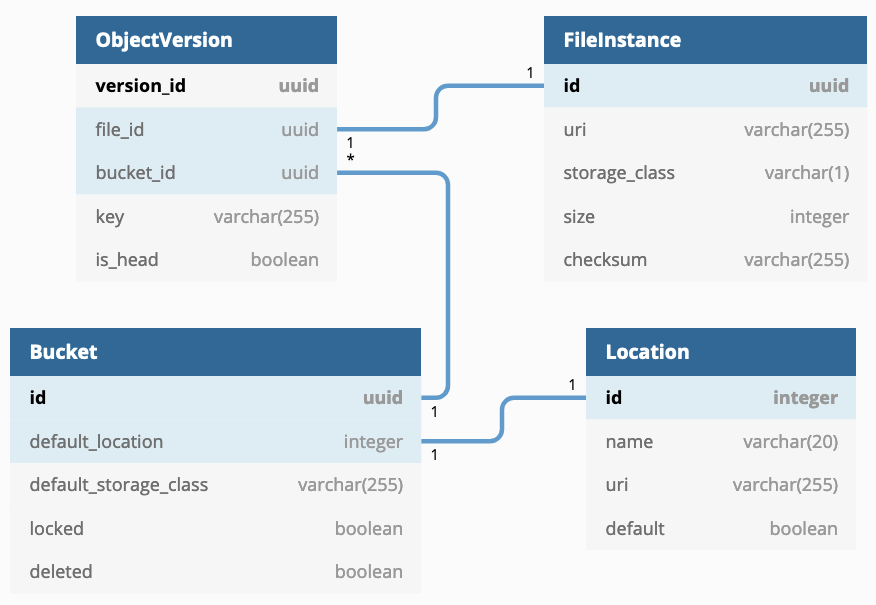Overview¶
Invenio-Files-REST is a files storage module. It allows you to store and retrieve files in a similar way to Amazon S3 APIs. It provides a set of features:
An abstraction of physical files storage.
Configurable storage backends with the ability to build your very own.
A robust REST API.
Highly customizable access-control.
Secure file handling.
Integrity checking mechanism.
Support for large file uploads and multipart upload.
Signals for system events.
The REST API follows best practices and supports, e.g.:
Content negotiation and links headers.
Cache control via ETags and Last-Modified headers.
Optimistic concurrency control via ETags.
Rate-limiting, Cross-Origin Resource Sharing, and various security headers.
Here is an introduction of the main concepts.

The physical layer¶
Provides physical access to files defining the storage locations and how to perform operations.
Location¶
A Location is a representation of a storage system. A location is described by its name
and URI. The URI could be a path in a local directory or a remote system.
For example, a location could have as a name shared-folder and URI /mnt/shared.
Among all defined locations, one has to be set as the default.
You can learn how to use Locations in the section Create a location.
Storage¶
A Storage provides the interface to interact with a Location and perform basic
operations such as retrieve, store or delete files.
Multiple storage can be useful, for example, to represent offline/online location so that the system known if it can serve files and/or what is the reliability.
By default, Invenio-Files-REST implements a storage for local files
invenio_files_rest.storage.PyFSFileStorage. It controls how files are physically stored,
for example the folders and files structure.
You can create new storage implementations and configure Invenio to use any existing storage. Check Storage Backends documentation for detailed instructions on how to build your own.
An example of a remote storage system is implemented in the module Invenio-S3 which offers integration with any S3 REST API compatible object storage.
FileInstance¶
A file on disk is represented by a FileInstance. A FileInstance
describes the path to the file, the used storage, the size and the checksum of the
file on disk.
To summarize
FileInstances are stored on disk in a specified Location using Storage APIs.
The abstraction layer¶
Provides an abstract way to logically represent, organise and manipulate files. This abstraction layer allows to perform files operations without physically accessing files.
ObjectVersion¶
An ObjectVersion is the logical representation of a version of a file and metadata at a
specific point in time. It contains the reference to the FileInstance that
it corresponds. For example, the file name is stored in the ObjectVersion metadata.
Note
File names could contain non-alphanumeric characters, which could be a problem depending on your file system.
For example, a user could upload a file named thesis&first*v1.pdf.
In Invenio-Files-REST, the default Storage will save the file in a tree of directories that are uniquely
named. The file name will be changed to data (with no extension) and the original file name will
be stored in the metadata of the ObjectVersion.
The final path to the file on disk will be something like /mnt/shared/2a/4f/39-5033-af42-k42m/data.
When an ObjectVersion has no reference to a FileInstance, it marks that the file has been
logically (and not physically) deleted. This is also known as
delete marker (or soft deletion).
Given multiple ObjectVersions of the same file, the latest (or most recent)
version is referred to as the HEAD.
ObjectVersions are very useful to perform operations on file’s metadata without directly accessing to the storage. For example, given that the filename is part of the ObjectVersion metadata, a rename operation is simply a database query to change its value.
Moreover, multiple ObjectVersion can reference the same FileInstance. This allows to perform
some operations more efficiently, such as create a snapshot without physically duplicating files or
migrating data.
Let’s see an example
A user uploads a new file called thesis.pdf.
With location and storage mentioned above, the file will be physically stored in /mnt/shared in a tree
of folders and with filename data (its FileInstance URI will be something like /<folders>/data).
The logical representation of the file, the ObjectVersion, will contain the reference to that FileInstance
and it will also store the filename thesis.pdf.
If, afterwards, the file is renamed to mythesis.pdf, a new ObjectVersion will be created with the
new filename keeping the reference to the same FileInstance.
If the file is then removed, a new ObjectVersion will be created with no reference to any FileInstance, without physically deleting the file on disk.
Bucket¶
A Bucket is a container for ObjectVersion objects.
Just as in a traditional file system where files are contained in folders, each
ObjectVersion has to be contained in a Bucket. The Bucket has a
reference to the Location where files are stored.
Buckets are useful to create collections of objects and to act on them. For example, bucket keeps track of the total size of the object if contains and allows definitions of quotas.
A bucket can also be marked as deleted, in which case the contents become inaccessible.
To summarize
Bucket contains ObjectVersions, a version of a file and its metadata. Each ObjectVersion has a reference to a FileInstance.
REST APIs¶
Invenio-Files-REST provides a set of REST APIs to create or manage resources such as Buckets or ObjectVersions. You can learn more about it in the REST APIs section of the documentation.
